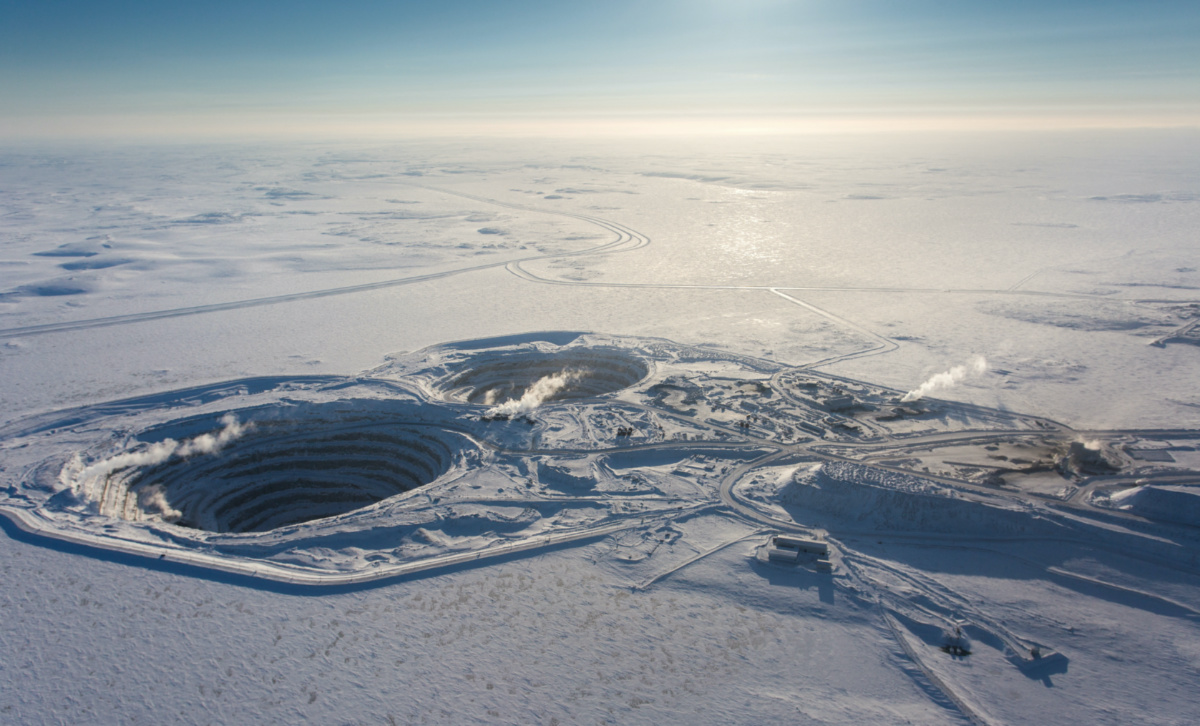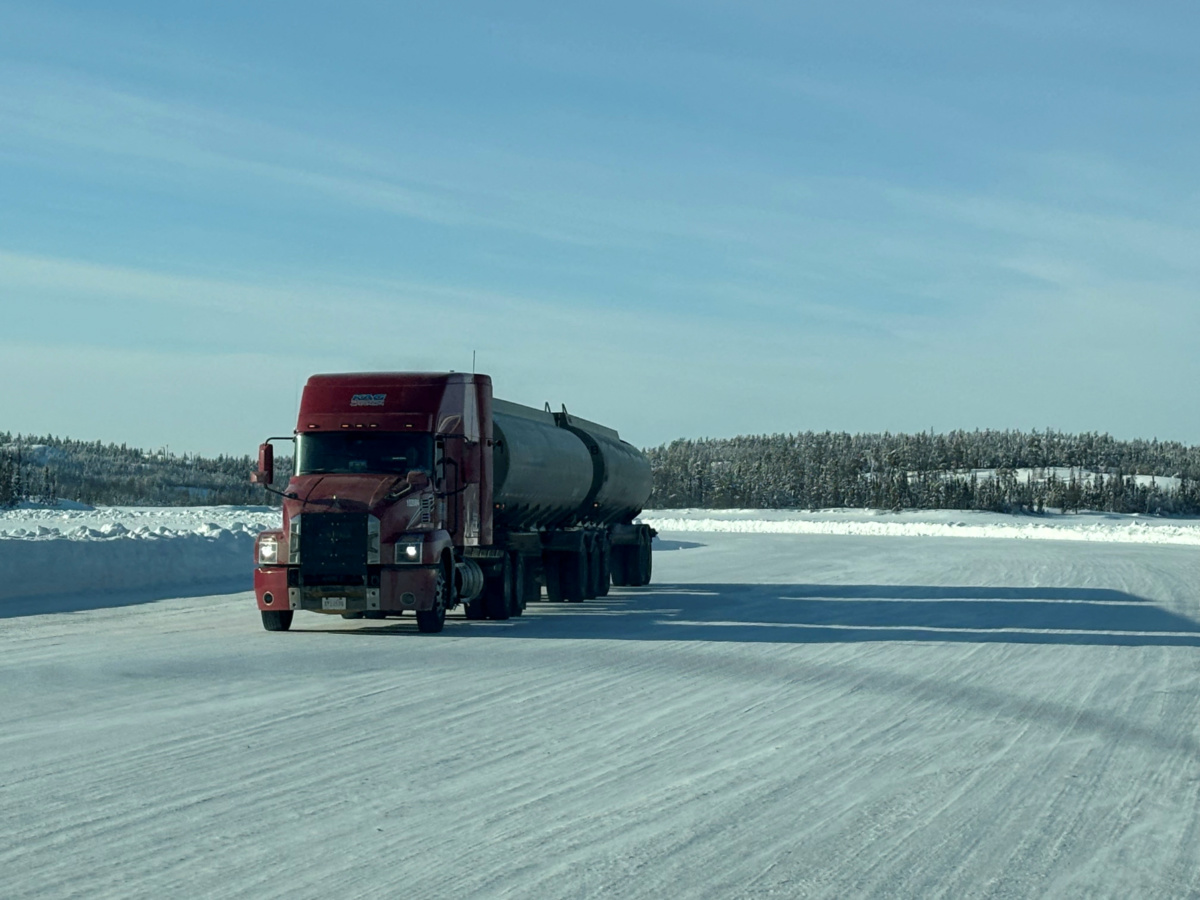Toronto, Canada
Reuters
An unusually warm winter in Canada this year has delayed the opening of a 400-kilometre ice road that is rebuilt every year as the main conduit for Rio Tinto, Burgundy Mines , and De Beers to access their diamond mines in the remote Arctic region.
The Winter Road, which serves the region accessible only by air for 10 months of the year, opened with a two-week delay in the middle of February, disrupting movement of goods along the ice road built over 64 frozen lakes.

The winter road is seen in the background of an aerial photograph of Rio Tinto’s Diavik Diamond Mine in the North Slave Region of Lac de Gras, Northwest Territories, Canada, on 12th February, 2015. PICTURE: Rio Tinto/Handout via Reuters
Earlier this week, the Tlicho government in Northwest Territories (NWT) restricted movement of commercial trucks for few days in one of the winter roads due to anticipated warmer weather across the North Slave Region.
While diamond production remains unaffected, the delay underscores the challenges that companies face as the mines that make Canada the world’s third largest diamond producer come to the end of their productive life.
It also highlights the infrastructure hurdle for the NWT and Nunavut that are positioning themselves as the next frontiers in the exploration of critical metals, such as rare earth, cobalt and lithium, in the transition to a greener future.
The delays in building the Winter Road, which first became operational in 1982, have happened in the past, but this year’s is the longest delay in recent years, according to Tom Hoefer, senior advisor to the NWT and Nunavut Chamber of Mines.
“We did start the road a bit later as a result,” he said.
Climate change, driven by the burning of fossil fuels, coupled with the emergence of the natural El Nino climate pattern, pushed the world into record heat territory in 2023.
The impact of El Nino this year resulted in Yellowknife, the capital of the NWT, recording a maximum temperature of zero degrees Celsius in December and minus 8.7 degrees Celsius in February, making it the warmest winter days in a decade, according to data from Environment Canada.
The Winter Road opens between late January and early April and requires minimum of 74 centimetres of ice for vehicles that can carry 26,000 kilograms of gross vehicle weight, to transport diesel and dynamite required to operate the mines.
On warmer days, the engineers have found ways to trick nature by creating artificial ice using giant sprinklers to spray water high up in the air so that they cool and form thick layer of ice when they fall.
Paul Gruner, CEO of the Indigenous corporation Tlicho Investment Corp & Group of Companies said this year the warm winter at the start and if there is a warmer end of the season or an early spring, it could risk an early closure.
“So when you’re nibbling away on both sides of that, you start to create a very short season,” Gruner said.

A truck drives on the winter road in the North Slave Region of Northwest Territories, Canada, in January, 2024. PICTURE: Hedley Rideout-Construction Superintendent/Handout via Reuters
The Winter Road is jointly operated by Burgundy Diamond Mines, Rio Tinto and De Beers of Anglo American group which run the Ekati, Diavik and Gahcho Kue diamond mines respectively.
De Beers and Burgundy Diamonds said operations at their mines have not been affected by the mild winter. Rio Tinto declined comment.
The Winter Road costs $C25 million to operate for two months, which is shared by the three companies based on goods transported on the road and distance traveled.
However, the mines have a operational life of around 20 years and as they reach the end of life, they need to be shut down.
Rio Tinto has said it will close the Diavik mine in 2026 and De Beers plans to shut Snap Lake end of this year, while seeking to extend the life of Gahcho Kue.
We rely on our readers to fund Sight's work - become a financial supporter today!
For more information, head to our Subscriber's page.
Chicken and egg
Canada‘s remote Arctic region, home to around 86,000 people, is facing the complete closure of all the diamond mines by 2030 and is looking for ways to keep mining alive.
The lack of infrastructure is a challenge and the shortened seasonal use of the ice road could hurt investments needed to mine critical minerals.
“If you’re in the exploration phase…and looking at using the winter road as part of your core business model, the risks start to come into…your decision making whether or not to advance a project,” Tlicho Investment’s Gruner said.
Hoefer of NWT and Nunavut Chamber of Mines said the two Northern territories, which are as big as Europe, have the highest infrastructure deficits in Canada – one of the reasons for the very high costs of living and doing business in the North.
“It is a chicken-and-egg situation, the mining companies probably won’t come unless there is some infrastructure, it’s just too expensive,” said Heather Exner-Pirot, director of Energy, Natural Resources and Environment program at Macdonald-Laurier Institute.
It costs $C3 million a kilometre to build gravel roads, Pirot said.
Mining groups are pushing for a mega infrastructure project that connects NWT to Nunavut that runs through the diamond mines could help unlock the mineral riches in the region. At least 23 of the 31 critical minerals listed by the Canadian Government is found in the NWT.
“When the project comes up, it would replace the roads that have served mining for 40 years, but until that happens, the ice roads are required,” Hoefer said.






